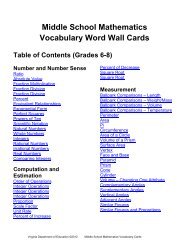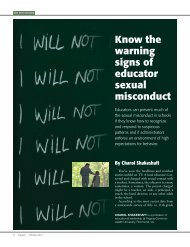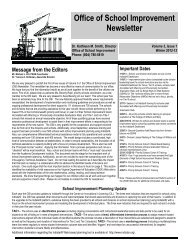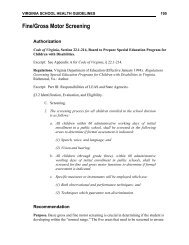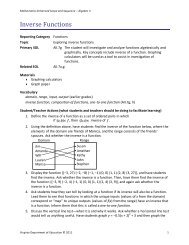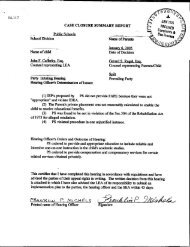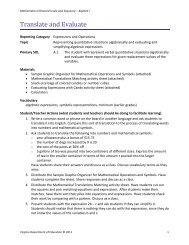What Makes Something Alive - Virginia Department of Education
What Makes Something Alive - Virginia Department of Education
What Makes Something Alive - Virginia Department of Education
Create successful ePaper yourself
Turn your PDF publications into a flip-book with our unique Google optimized e-Paper software.
Session 6.10 – Yum Yum Caterpillars<br />
Teacher Questions & Notes<br />
-Which colors <strong>of</strong> caterpillars are left?<br />
-Which do you see more clearly?<br />
-<strong>What</strong> colors blend more into the grass<br />
or ground?<br />
-Why is color helpful to caterpillars?<br />
To birds?<br />
-<strong>What</strong> is the word we use when<br />
something blends into the<br />
environment? (camouflage)<br />
-<strong>What</strong> other animals use camouflage?<br />
Procedures<br />
8. Allow about two minutes for the students to retrieve five<br />
caterpillars.<br />
9. After the caterpillar search is complete, have students return to<br />
the area where they originally hid their caterpillars. Have each<br />
student check the five locations where they hid their caterpillars.<br />
If any <strong>of</strong> their caterpillars were not found, have them retrieve the<br />
caterpillar. Discuss as a group why some <strong>of</strong> the caterpillars were<br />
not found. Put any caterpillars that were not found during the<br />
search, but have now been retrieved by the original student, in<br />
the original bag/box. These caterpillars will not be a part <strong>of</strong> the<br />
remaining activities in this session.<br />
10. Create a graph on the ground or other large space <strong>of</strong> the collected<br />
caterpillars using the actual chenille stems that were found.<br />
11. Use the graph to discuss which caterpillars were most readily<br />
collected and why. Continue the discussion about camouflage<br />
and brainstorm about other animals that also use camouflage.<br />
12. Tally the caterpillar data as a class.<br />
13. Have the students pick up all the caterpillars that they had found<br />
from the graph.<br />
-<strong>What</strong> are the parts <strong>of</strong> a bar graph?<br />
14. In the classroom, have the students recall the parts <strong>of</strong> a proper bar<br />
graph.<br />
15. Write the parts <strong>of</strong> a bar graph on the board for review as the<br />
students name them.<br />
-<strong>What</strong> would be a good title for our<br />
graph on collected worms?<br />
-<strong>What</strong> labels do we need? (colors <strong>of</strong><br />
chenille stems used)<br />
-Given our data, what would be a good<br />
scale to use?<br />
16. Discuss an appropriate title and scale for a graph about the<br />
collected caterpillars.<br />
17. Write the tallies <strong>of</strong> the collected data on the board or on a chart<br />
so that the class can see them.<br />
18. Have students create their own bar graphs using the given data.<br />
This can be done on a blank page in their journals or on the<br />
Graphing sheet (pg. 217).<br />
19. Have the students write two true statements and two false<br />
215<br />
<strong>Virginia</strong> Animals and their Habitats<br />
Topic 6



